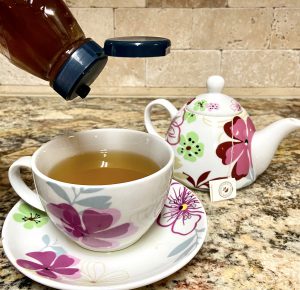
by Ginny Hinton | Aug 17, 2020

Honey or Sugar
Photo Source: Ginny Hinton
Sugar or honey? The debate rages on, with honey probably edging out sugar in popularity. Many people use local honey because of it’s supposed benefit to allergy sufferers (immunotherapy). Others prefer it because it’s processed less than sugar, or because they simply love the taste.
People have been eating honey – or slathering it on their bodies – for hundreds of years. In ancient times, honey was used as a sweetener, as medicine to heal wounds, to relieve stomach problems, and even to fight bad breath. It has many of the same uses today. Honey contains trace amounts of acids that contribute to its antimicrobial activity, so when used on the skin it really can help heal wounds and reduce scar formation. The antioxidants in honey have been linked to properties that may fight cancer. Honey inhibits inflammation, leading to a protective effect for the heart and the whole cardiovascular system, and it’s a great remedy to help ease a bad cough. Does local honey really relieve allergies? There is some anecdotal (personal) evidence, but the jury is still out on that with no consistent clinical study results.
So, how do honey and sugar compare nutritionally? To start, both are carbohydrates, made up mainly of glucose and fructose. The body breaks them both down quickly and they each cause a spike in energy and blood sugar levels, although honey has a somewhat gentler effect. Honey weighs in with more calories at 68 per tablespoon versus sugar’s 49 calories per tablespoon. To balance out the calorie factor, honey is sweeter than sugar, so you may need to use less of it in your food. Honey may also be easier to digest because bees have already added enzymes that start to break it down. The bottom line is that both sugar and honey are sweeteners, they are nutritionally very similar, and using too much of either can lead to unwanted consequences such as weight gain, risk of illness, and tooth decay. Whether you use sugar or honey, it’s a great idea to limit consumption. The following tips may help, whichever sweetener you decide to use:
* Cut the amount of sweetener you use for drinks or
cooking in half and see if you still like the taste.
* Cut sweetener in baking by 1/3 or substitute mashed
banana for the sweetener.
* Add spices to substitute for some of the sweetener in a
recipe. Examples that add flavor without the calories are
almond, vanilla, and cinnamon.
Whatever tip you use, you’ll be ahead of the game if you can gradually cut the amount of sweetener you use, whether for cooking, baking, or drinking.
For more information about honey, sugar, or general nutrition, contact your local UF/IFAS Extension Agent.

by Laurie Osgood | Jun 15, 2020

Photo Source: Laurie Osgood
With everything going on in the world today, it could be easy to forget one of the most important holidays of the year, Father’s Day. We will celebrate Father’s Day on June 21st this year, during Men’s Health Month! Father’s Day is a good time to show the men in our lives that we want them to be with us for a long time. Let’s celebrate Men’s Health Month by encouraging the men in our lives to adopt healthy habits and seek regular medical advice.
Most men do not like to go the doctor. A 2014 survey conducted by The Centers for Disease Control (CDC) determined that American men are much less likely to go to the doctor than women. Starting a conversation could encourage him to pay attention to his health as he ages. But how do we start the conversation with our father’s about their health issues? To ensure a stress-free conversation, pick a time and place with few distractions and present the topic in a loving and non-judgmental manner.
Here Are the Top Healthy Living Tips for Men:
- Schedule an annual physical exam: Annual physical exams can help spot potential problems before they get serious. Only you and your doctor can determine your best checkup and screening schedule. Preventative screenings such as an annual colonoscopy are based on a patient’s age and risk factors for developing a condition or disease, including family or personal history, age, ethnicity, and environmental exposure.
- Recognize the Signs and Symptoms of a Heart Attack: According to the American Heart Association, someone in the U.S. has a heart attack every 40 seconds. Therefore it is important for everyone to recognize the signs of a heart attack. These warning signs include pain or discomfort in the jaw, chest, arms, shoulders, neck, or back, feeling light-headed or weak and shortness of breath.
- Make sleep a priority: Many adults don’t get enough sleep. Sleep is essential for our bodies to maintain our healthy bodily functions. Sleep disorders and ongoing lack of sleep can increase the risk of heart disease, high blood pressure, stroke, and diabetes.
- Reduce Stress: High levels of stress can negatively affect a man’s lifestyle. Stress can be life threatening and can lead to a heart attack. UF/IFAS Extension’s Electronic Data Information Source (EDIS) offers a collection of information on various subjects including how to manage stress.
- Stop Smoking: Men who smoke are at a greater risk for heart disease, cancer, respiratory diseases and strokes. Quitting can help lower the risk for smoking-related illnesses. The Florida Department of Health’s Tobacco Free Florida campaign offers resources to help quit tobacco use.
- Exercise More: Regular workouts can improve heart health as well as reduce stress and weight. Experts tell us that we should all try to get at least 30 minutes of moderate physical activity each day to maintain a healthy lifestyle.
- Eat Healthy: A healthy diet should include a variety of fruits and vegetables, whole grains, lean meats, and low-fat dairy products daily. USDA offers tips for Men’s Health; 10 Tips: Get the Facts to Feel and Look Better .
Father’s Day is a great time to celebrate the men in our lives and encourage them to pay attention to their health and well-being because we want them to be around for a long time.
Going to the doctor may not be as fun as going to a ballgame or the beach, but having a conversation about their health may be the gift we can give our fathers on Father’s Day.
For more information on healthy living or other extension related topics, contact your local UF/IFAS Extension Agent.
Extension classes are open to everyone regardless of race, creed, color, religion, age, disability, sex, sexual orientation, marital status, national origin, political opinions or affiliations.

by Julie McMillian | May 11, 2020
What does your morning and evening routine consist of? Now that we are adjusting to our new normal of staying at home and social distancing, many routines are different than before. How about starting a routine of walking 30 minutes or an hour each day? There are so many positive benefits to even just adding 15 minutes to your schedule and most everyone, including children, can do it.

Walking is a great form of exercise that nearly everyone can do. (Photo source: Lyon Duong, UF/IFAS)
Walking improves your mood and reduces stress and anxiety. Who doesn’t need that kind of positive influence in their life right now? If you walk in the morning, it will provide you with energy for the rest of the day and walking in the evening helps you to sleep better at night. Taking a few extra steps each day can add some time to clear your head and add to your energy level while creating a positive mindset for other activities.
One of the other benefits of walking is burning calories. Burning calories may lead to weight loss. It seems that almost every American is always looking for a way to improve the fitness of their body. By exercising during a walk, you build stronger muscles, ligaments and tendons. Physically, walking can reduce your hips, tighten abdominal muscles, strengthen your arms, and tone your legs. Walking gives you a chance to improve balance, coordination and flexibility. Your feet can help to reduce the load on other joints while keeping knee joints healthy and lowering the risk of blood clots. Walking makes your heart stronger and reduces risk of stroke. A research team from the University of Michigan Medical School says that people who are in the 50s-60s age bracket who exercise regularly are 35 percent less likely to die in the next eight years than those who do not. Therefore, some walking each day could help you lead to a longer life.
Now that we have so many reasons to take a stroll each day, we must make sure to walk correctly to avoid injury. It is important to move freely and naturally while swinging your arms to avoid back problems. Keep your shoulder back with your head held high and eyes forward. Position your feet straight and push off with your hind leg to engage your hips. Watch for traffic if you are walking by a highway and of course practice social distancing for now. Maybe later ask a friend to join for a social aspect and to have accountability to someone. Keep a log to track progress. The CDC recommends 150 minutes of moderate activity per week to be considered active adults. That should add up to about 7,000 to 8,000 steps a day but if you can get 10,000, go for it! It is a great time to get into this daily routine and doesn’t require any special equipment or memberships.
So what are you waiting for? There is no better time to start stepping.
For more information on healthy living or other extension related topics, contact your local UF/IFAS Extension Agent.
Additional Resources:
Healthstyle: A Self-Test (UF/IFAS Extension)
Healthy Living: Beating Barriers to Physical Activity (UF/IFAS Extension)
Improving Savings, Health, and Happiness by Modifying How the Family Operates the Home (UF/IFAS Extension)
Walking: Your Steps to Health (Harvard Health)
UF/IFAS Extension is an Equal Opportunity Institution.

by Laurie Osgood | Mar 26, 2020

The goal of National Healthcare Decision Day is to inspire Americans to communicate their end-of-life wishes about healthcare with their families and healthcare providers.
Although making healthcare decisions is often a difficult process, making decisions for others is even more complicated.
According to the 2018 Conversation Project national survey, Americans are becoming more comfortable talking to their loved ones about their end of life wishes. Over half (53%) of Americans say they would feel relieved if a loved one started “the Conversation.”

Start the family “conversation”
Photo Source: Laurie Osgood
Once you have initiated the conversation, experts recommend creating an advance care directive. Advance care directives are legal documents that are used to secure your decisions about end-of-life care, to avoid confusion and uncertainty later on. These legal documents can include a living will, health care proxy, health care power of attorney or instruction directive. Having an advance care directive in place will help make sure that your wishes about your health care are fulfilled, even if you are no longer able to communicate your wishes.
Don’t wait for “the right time” to talk with your family, everyone should plan for their future, before a crisis arises.
There are many tools and online resources that can help you and your family begin this important conversation.
To learn more about National Healthcare Decision Day and advance care directives. Visit NHDD.org.

by Melanie Taylor | Mar 12, 2020

Speak openly with your doctor about any concerns you may have regarding your health. (Photo source: Tyler Jones, UF/IFAS)
We are in the depths of flu season and now the Coronavirus (COVID-19). Although we need to proceed with caution, we also want to avoid causing a panic. Both viruses are very concerning, but with good hand washing skills and a few other daily steps you can do your best to prevent you and your family from becoming sick.
Hand washing is one of the best ways to protect yourself and your family from getting sick. You can help yourself and your loved ones stay healthy by washing your hands often, especially during these key times when you are likely to get and spread germs:
- Before, during and after preparing food
- Before eating food
- Before and after caring for someone at home who is sick with vomiting or diarrhea
- Before and after treating a cut or wound
- After using the toilet
- After changing diapers or cleaning up a child who has used the toilet
- After blowing your nose, coughing or sneezing
- After touching an animal, animal feed or animal waste
- After handling pet food or pet treats
- After touching garbage
Follow these Five Steps Every Time You Wash Your Hands:
- Wet your hands with clean, running water (warm or cold) and apply soap.
- Lather your hands by rubbing them together with the soap. Lather the backs of your hands, between your fingers and under your nails.
- Scrub your hands for at least 20 seconds. Need a timer? Hum the “Happy Birthday” song from beginning to end twice.
- Rinse your hands well under clean, running water.
- Dry your hands using a clean towel or air dry them.
Use Hand Sanitizer When You Can’t Use Soap and Water
You can use an alcohol-based hand sanitizer that contains at least 60% alcohol if soap and water are not available. Washing hands with soap and water is the best way to get rid of germs in most situations. If soap and water are not readily available, you can use an alcohol-based hand sanitizer that contains at least 60% alcohol. You can tell if the sanitizer contains at least 60% alcohol by looking at the product label.
- Sanitizers can quickly reduce the number of germs on hands in many situations.
- Sanitizers do not get rid of all types of germs.
- Hand sanitizers may not be as effective when hands are visibly dirty or greasy.
- Hand sanitizers might not remove harmful chemicals from hands like pesticides and heavy metals.
How to Properly Use Hand Sanitizer:
- Apply the gel product to the palm of one hand (read the label to learn the correct amount).
- Rub your hands together.
- Rub the gel over all the surfaces of your hands and fingers until your hands are dry. This should take around 20 seconds.
Caution! Swallowing alcohol-based hand sanitizers can cause alcohol poisoning if more than a couple of mouthfuls are swallowed. Keep it out of reach of young children and supervise their use.
Conclusion – Other Basic Tips to Prevent Spread of Illness:
- Wash your hands often with soap and water for at least 20 seconds. If soap and water are not available, use an alcohol-based hand sanitizer.
- Avoid touching your eyes, nose and mouth with unwashed hands.
- Avoid close contact with people who are sick.
- Stay home when you are sick.
- Cover your cough or sneeze with a tissue, then throw the tissue in the trash.
- Clean and disinfect frequently touched objects and surfaces.
Be sure to utilize credible sources to find your information. The Centers for Disease Control and Prevention (CDC) and the Florida Department of Health are excellent resources.
CDC page Preventing COVID-19 Spread in Communities https://www.cdc.gov/coronavirus/2019-ncov/community/index.html
CDC frequently asked questions (FAQs) https://www.cdc.gov/coronavirus/2019-ncov/downloads/2019-ncov-factsheet.pdf
Florida Department of Health frequently asked questions (FAQ) http://www.floridahealth.gov/diseases-and-conditions/COVID-19/faq.html
If you have further questions or concerns, please contact your local Department of Health for assistance.
Sources:
Center for Disease Control and Prevention – https://www.cdc.gov/
Florida Department of Health – http://www.floridahealth.gov/











